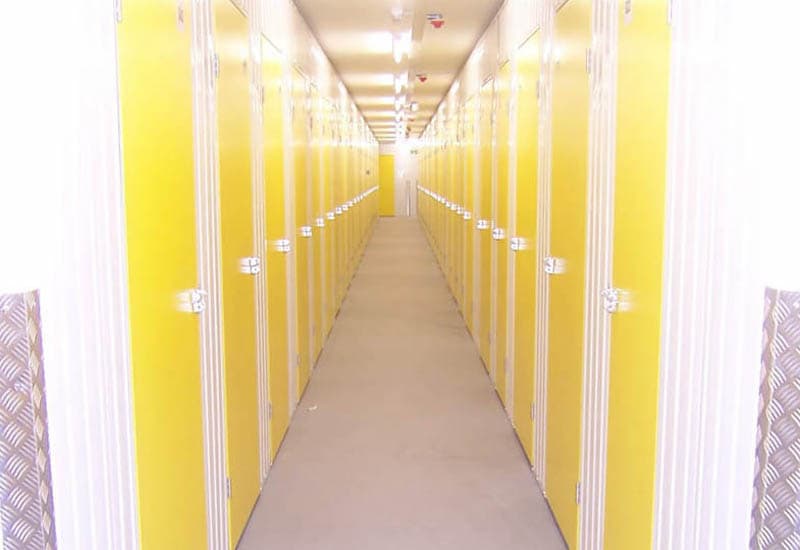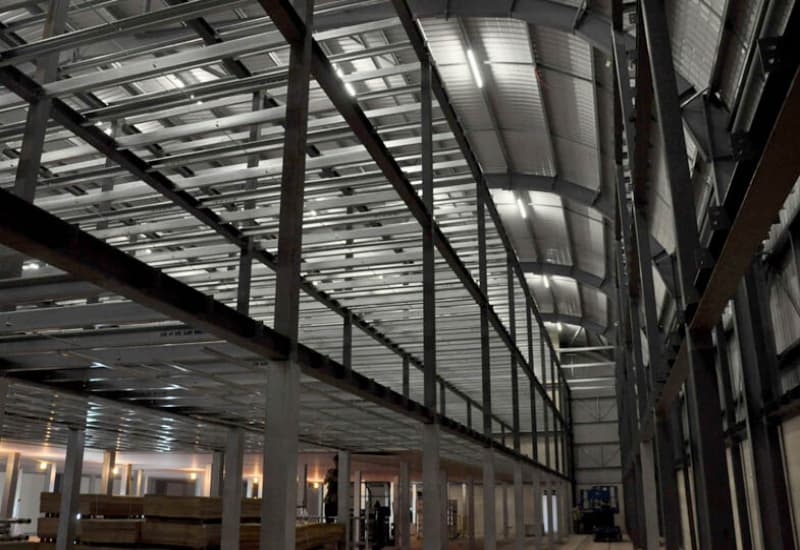- Mezzanine Floors
- Solutions
- Multi-Tier Mezzanines
- Mezzanine Pallet Safety Gates
- Mezzanine Staircases
- Mezzanine Handrails and Balustrades
- Mezzanine Decking
- Fire Protection for Mezzanine Floors
- Mezzanine Lift Shaft Design and Installation
- Resources
- Mezzanine Floor Calculator
- Mezzanine Floor Regulations and Building Control
- Self-Storage Mezzanine Floors
- Self-Storage Units
- Resources
- Self-Storage Site Selection Information
- Calculating The ROI of Self-Storage Conversions
- Planning for Automation in Self Storage
- Racking & Shelving
- Solutions
- Cantilever Racking
- Pallet Racking
- Coil Racking
- Longspan Shelving
- Tyre Racking
- Kimer Racking
- Live Storage Racking
- Drive In & Drive Through Racking
- Clip Shelving
- Mobile Shelving
- Custom Fabrications
- About Us
- USS Case Studies
- Self-Storage Fit-out For Raked Ceiling Building
- Mezzanine And Staircases For Entertainment Venue
- New Mezzanine And Staircases For Major Retailer
- Mezzanine Pallet Safety Gate
- Self-Storage Fit-Out Project For Brand New Facility
- Warehouse Racking, Wire Mesh & Shelving for New Warehouse
- Self-Storage Partition System & Components Installation
- Self-Storage Store Mezzanine And Staircases
- Multi-Tier Mezzanine For Logistics & Distribution Facility
- Warehouse Plant Platform
- Self-Storage Facility Space Expansion
- Mezzanine Floor For Distribution Warehouse
- Bespoke Feature Staircase & Mezzanine
- Single Level, Multi-Use Mezzanine
- Mezzanine For A New Building
- Mezzanine Floor For Plumbing Supplies Warehouse
- New Racking System and Mezzanine Floor
- Car Park Conversion To Self Storage Facility
- Pallet Racking and Cantilever Racking For Warehouse
- Two Mezzanine Floors For Self-Storage Facility In Birmingham
- Our Accreditations
- Contact Us
- USS Case Studies
The Latest Blogs From USS
Self-storage Expansion and Improvement Projects On The Rise As Customers Increase
read

We’ve been in the storage solutions industry for over 45 years now, including designing and installing mezzanine floors in self-storage facilities. During this time we’ve seen the sector grow across the board; we’ve also seen a shift in the reasons people opt for self-storage.
Our work with some of the leading names in self-storage provision has given us a unique insight into the demands placed on the facilities they provide for their customers. Not only do we supply partitions and doors for self-storage unit installations; we also provide accessories and options such as lift shafts and staircases, as well as final touches like decorative finishes and protective bollards in front of lifts for example. It is this insight which has driven the development of the self-storage mezzanine floors we put in. From a single floor to multi-level installations, we help clients to maximise their options, expanding up rather than out as a cost-effective means of creating new and multi-purpose spaces. Our floors can be fitted with a reduced number of columns, for example, in order to create an open-plan reception area with smaller self-storage areas adjacent. All of this expertise put together means that we can provide genuinely bespoke self-storage solutions for the facility owners.

Self-Storage Has a High Customer Satisfaction Rate
Looking at the latest annual industry report from the Self-Storage Association it’s clear that the sector is well-placed to ride out the economic fall-out from COVID 19 and the accompanying lockdown.
The findings, for example, included the fact that 91% of customers are satisfied with the self-storage service they have received and 48% of the public have a good awareness of self-storage as a concept. The breakdown of the demographics of the people who utilise self-storage which is contained within the report helps to illuminate the demands which are now being placed on providers. According to the report, 69% of users of self-storage are in the age range of 40-79 years, 32% are involved in moving home and people who are divorced or separated are twice as likely to be using self-storage. When we combine this with our own experience it’s possible to draw up a list of the factors which are driving the uptake of self-storage solutions and the facilities which users are looking for.

We can see that the sector is buoyant and that growth in the future will be driven by a range of issues, not least of which is the fact that new-build houses and flats across the UK tend to be designed with limited in-built storage space. When this is coupled with the fact that houses now tend to be built without garages attached, a situation is created in which more and more people simply don’t have the space to store the possessions they’ve built up over a period of time, particularly when, according to the government’s own statistics, the average age for couples getting married is 38.0 years for men and 35.7 years for women. Although this may have followed a period of cohabitation in some cases, in many it will mean two households being combined, leading to an excess of possessions which are too valued to be disposed of but too numerous to store within the home, hence the decision to turn to self-storage.
Rental Sector Volatility Driving Demand
Another less cheerful driver of the demand for self-storage is the volatility of the rental sector within the UK, in particular the fact that people tend to shift from property to property on a regular basis. This means that someone might be evicted after just three months, which is when they need to store their possessions while they find somewhere else to live. In many cases, the process of shifting everything back out of storage can take another couple of months, by which time the cycle has started again and the user has to start looking for another place to live. We’ve witnessed this happening ourselves, and while it’s clearly stressful for the individuals involved, the availability of flexible and affordable self-storage does at least remove one difficulty.
At the other end of the housing spectrum, many people upgrading from one house to another find themselves reassessing the furniture, appliances and other possessions they’ve built up over the years and deciding that they only want to put the basics into their new place and build again from there. This means everything else going into a self-storage unit, and for the first year, the homeowners in question tend to visit fairly regularly, while this falls away the longer the items are in storage.
The number of times the average UK homeowner moves house will vary depending on their personal circumstances and the state of the wider housing market, but several surveys have shown that the average number of such moves in a lifetime is seven, which means the purging and de-cluttering process outlined above is likely to happen once every seven years. That’s certainly a pattern we’ve noticed – after the first year the items in self-storage are pretty much ignored, and then six years later the client suddenly wants to take a look through them to see if there’s anything they’d like to move to their next home. Of course, this also involves getting rid of some of the extra items they’ve built up over the preceding seven years, and so the process starts all over again.
Self-Storage As a Solution For Many of Life’s Changes
Another significant life event which often triggers the need for self-storage is the death of a loved one and the inheritance which this involves. In many cases, people don’t necessarily want to keep the items which someone has passed on to them, but the circumstances mean that they can’t bring themselves to simply dispose of them, whether by selling, donating to a charity or simply junking. The solution is to put the inherited items into self-storage, where they are likely to stay for years on end. An extravagant self-storage solution which probably applies only to the more affluent sectors of the market involves people dividing their wardrobe into summer clothes and winter clothes and storing six months’ worth of winter clothing in summer and vice versa. We’re not sure whether having a winter wardrobe in storage is set to be the new equivalent of an eye-catching ‘walk-in shoe closet’, but it’s definitely something we’ve seen!
Multi-Purpose Self-Storage Spaces On The Rise
One interesting area of growing demand which we’ve also become aware of is the trend for transforming what would traditionally have been storage space into ultra-affordable office units. At its simplest, this involves equipping an empty unit with a couple of desks, some battery-powered laptops and smartphones, making it possible to work from the unit, and many self-storage facilities now include serviced offices, and it is, of course, possible to have the unit decorated in such a way that it becomes a comfortable and pleasant place to work, using techniques such as a large photographic image mounted along the length of one wall.
No matter what purpose the self-storage unit is put to, the installation of a mezzanine floor to maximise the space is a step which has to be completed before anything else can happen – such as following on trades like electricians or installation of security equipment and so on.
Bottom line? We recommend working with a team of experts who can not only advise on the best approach whether you’re considering a storage facility upgrade or just starting out on repurposing an existing building. Don’t leave anything to chance, there’s plenty of expertise out there to help you make your project a success!
Would You Like Advice About a Self-Storage Mezzanine Floor or Expansion Project?
Simply fill in our contact form to start a conversation and find out how USS can help make your self-storage facility project a success!
This blog is for information purposes only and should not be construed as legal or financial advice and not intended to be substituted as legal or financial advice.
Find Us
S & L United Storage Systems Ltd
United House, The Street
Takeley, Bishop's Stortford
Hertfordshire, CM22 6QR
Company No. 1313816
VAT No. 291616253Say Hello
01279 871 787Copyright © 2025 S & L United Storage Systems Ltd. All rights reserved.
- About Us









